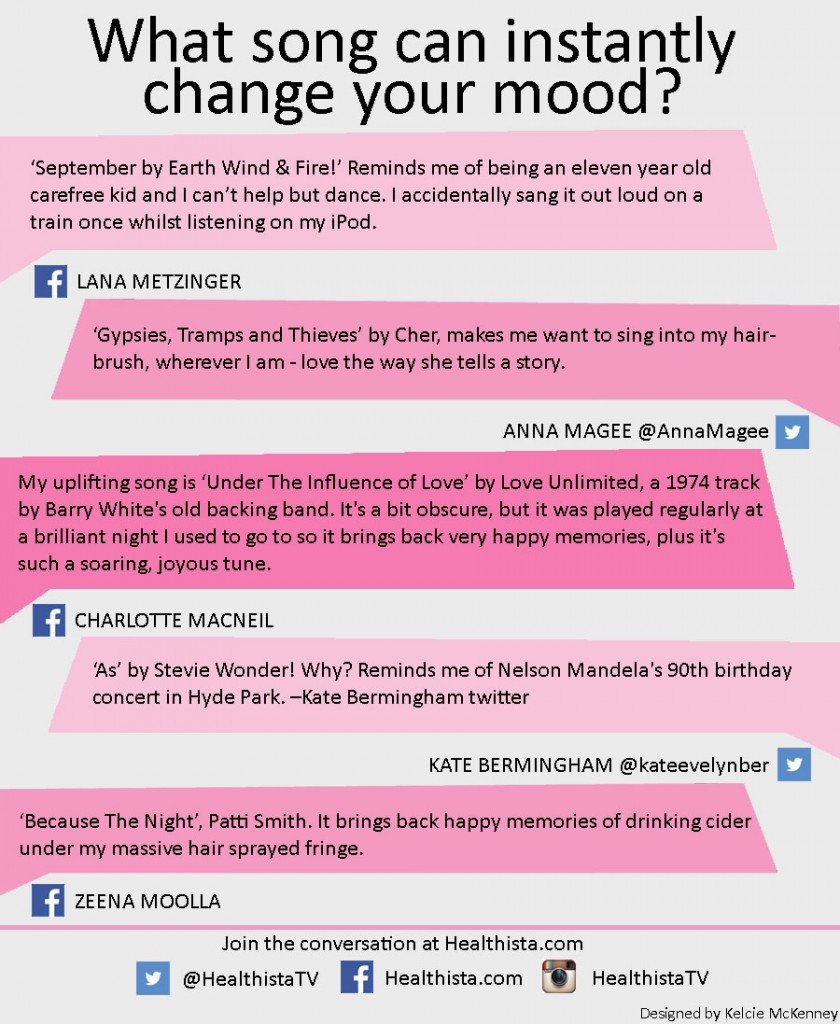Do you have a song that instantly makes you relax or immediately pumps you up? Kelcie McKenney investigates exactly why music affects our moods so deeply and finds out how to make it work for you
As a child raised on Enya and dancing in the kitchen with my mother, I’ve always had an affinity to soothing and relaxing music. Growing up I’ve developed a fast paced and busy lifestyle, where I’m constantly on the move, and I’ve found that the only moment I can sit back and relax is when my iPod headphones are in. The majority of my music library is filled with slow, melancholy songs with somber lyrics and calming melodies. Could it be that I’m self-medicating my mood with my choice of music? And why indeed does music so profoundly affect our emotional state?
The song Weightless by Marconi Union was recently described by music pundits as the most relaxing song ever. Filled with soothing rhythms, guitar, piano and natural soundscapes, the song was found to be beneficial in calming people down after testing by the British Academy of Sound Therapy. The study found that Weightless reduced anxiety in female participants by 65 per cent which was 35 per cent lower than their normal resting levels of anxiety. Listeners were relaxed and calmed simply by listening to the eight minute long track.
Marconi Union was commissioned by the British Academy of Sound Therapy to write this relaxing piece of music and then later created an album with five additional tracks to accompany the song. While the band took advice from sound therapists for their song ‘Weightless,’ the band’s intention for the album was simply to make music they liked.
‘With the exception of the track Weightless that we were commissioned to do,’ says Richard Talbot, one member of the musical trio, ‘We’ve never set out to write relaxing music we’ve set out to make music with atmosphere.’
Exactly Why Music Relaxes Us
Marconi Union’s seven other albums have a similar atmospheric and relaxing feel, but what makes Weightless different is a the mood changing suggestions they received from sound therapists.
‘The big piece of advice that we took on board was the bass drum that has a pulse to it,’ Talbot says. ‘Right from the start it has a boom boom sound like a heartbeat that slows down over the song. This we learned was because of a process called entrainment where your brain, heart and body sync with the music – because the base drum slows down over a certain period of time, your heartbeat slows down with it.’ Fascinating.
Entrainment causes your body to sync with the music that you’re listening to and since Weightless has a uniquely designed bass drum slowing down over the song, it causes listeners’ heart rates to slow down with it.
That process of entrainment is one proven way music affects our brains, explains Dr Costas Karageorghis, a sports psychologist with a background on musical influence at Brunel University. Entrainment is a phenomenon discovered by Dutch scientist Christian Hagans when he was experimenting with pendulum clocks. Hagans found that when two pendulum clocks were on opposite walls of each other swinging at different rates, after some time the two pendulums would always sync.
That same phenomenon works with our brain and music. How could that be?
‘It appears that there are several bodily pulses that – whether we want to or not – will link into the qualities of the music and resonate with the music,’ says Dr Karageorghis. ‘For example, our brainwaves will sync with the music, our respiration rates, or how fast we breathe, will also sync with the rhythmical qualities of music as will our heart rates and even our bodily movements.’
What’s Really Up With Music and Your Mood
But music doesn’t only lead our bodies to relax, it can alter other aspects of our mood and emotions too. Indeed, studies have found that different types of music can drastically change how we feel simply by listening to them.
A study by the Institute of HeartMath found that different types of music had consistently similar changes to mood. The study played four different types of music; classical, new age, grunge rock and designer music (music created specifically to change moods), to over a hundred listeners to test how the different genres affected how they felt.
The study found that grunge rock increased hostility, tension and sadness while designer music increased caring, mental clarity and relaxation consistently. It also found classical music created a reduction in tension and new age created an increase in relaxation and reduction in hostility across the board.

Part of the reason these genres of music consistently alter moods in a similar way is tied to entrainment, with the linking of the heart rate and breathing rate. But these affects also relate to the rhythmical qualities of the music and the lyrical affirmation that is associated with the songs, explains Dr Karageorghis. For example, grunge rock has more hostile lyrics compared to classical music or new age that is either only instrumental or has soothing and nonspecific vocals to it. Not only does the rhythm of a song affect the way we feel, but the words being sung to us do too.
The affect music has on us is actually an automatic reaction engrained in our brains. ‘There is something primal about this,’ says Dr Karageorghis. ‘At a subconscious level, music is able to influence us without conscious processing.’ In other words, whether you want it to or not, music will change the way you feel.
Music Therapy: Using Music to Heal
Music therapy uses our primal response to sounds, pitches and rhythms to create music between therapist and client that can heal emotional wounds and trauma. This primal reaction can be seen as early as between newborn babies and their mother. The first form of communication is through sounds and pitches with the crying of the baby being comforted by the cooing of the mother. It’s a musical exchange that we’re all introduced to before any verbal interaction. In music therapy, therapists use music and our primal responses to work with people who are dealing with psychologial and emotional issues in a way that lets them express themselves without words and instead through instruments, songs and music.
During a music therapy session, clients can choose from a selection of instruments available, such as drums, tambourine, piano, guitar and other playful instruments. The client can play with them however they like to express what they’re feeling, and the therapist will responds to the client’s music with music of their own as a way to connect with them, emote to them and express that they’re listening to them.

‘It’s an intuitive thing,’ says music therapist of the British Association of Music Therapy June Stoll from North London who primarily uses piano during her sessions. ‘I would be finding the right kind of chords, intervals, density and pace of music. I’d be reading the client musically and reflecting, supporting and encouraging from the piano with my sounds. That way the client gets a real sense of being heard and listened to and hopefully, a strong sense of trust will develop between us enabling change and growth to happen.’
You don’t need to play well or have a great voice if you’re thinking about trying music therapy. It’s instead about tapping into primal responses through music in order to explore, express and connect with your inner emotions.
‘You can talk yourself round in circles,’ Stoll says, ‘and that tends to happen when you get anxious, but music is a way to step outside of that and music therapy is a way to do that in a creative and supportive environment.’
The ‘Our Song’ Phenomenon
Most couples have an ‘our song’ right? This is down to extra-musical association, which is actually referred to by therapists and scientists as the ‘our song phenomenon.’ That’s where we link a piece of music to a positive memory or time in our lives of emotional significance, explains Dr Karageorghis. For instance, a couple hears a song in a restaurant or bar many years into their relationship and say ‘that’s our song’ because it happened to be playing on their first date and they’ve associated it with the happy feelings from that memory.
The ‘our song phenomenon’ is used by athletes pre-competition too. At the 2008 Bejing Olympics, celebrated American swimmer Michael Phelps listened to a track called ‘I’m Me’ by Lil’ Wayne when he won a record number of gold medals. The refrain of that song has strong lyrical affirmation, with lyrics stating ‘Yes, I’m the best. And no, I ain’t positive, I’m definite. I know the game like I’m reffing it.’ The way he felt from his success at the Olympics became associated with the ‘I am Me’ song he listened to.
‘Four years later when Phelps was in London for the Olympic games again and had another medal fest,’ Dr Karageorghis says, ‘he listened to exactly the same track in order to engender that optimal mindset and have the optimal constellation of emotions that associated with peak performance.’
Phelps’ mental mindset towards his athletic abilities was improved because the song helped him to remember the way he felt at the prior Olympics when he was so successful.
But extra-musical association, the ‘our song phenomenon,’ isn’t only for athletes and couples. It can work in just about any context, says Dr Karageorghis. ‘It might be a politician making a speech, for example. Or it might be a situation where an individual is going for a job interview and they listen to a sedated piece of music, one that they associate with relaxation, in order to engender the right kind of mindset.’
Is a song popping into your head that you tend to listen to change your mood? Do you have a track you use to calm yourself down when stressed? Do you have a booster song that pumps you up at the end of your workout? You just might be using the ‘our song phenomenon’ already. Here are some of the results of our straw poll.
Using Music to Motivate Your Workout
All of these effects can be also be used to pump you up and benefit your exercise. Most of us know that listening to music at the gym is a way to get pumped and stay determined during a workout. But Dr Karageorghis and his research team at Brunel University in London proved this in their research. They tested music tempo and their effects on exercise over ten years and found that carefully-selected music can reduce perceived exertion (how hard you’re working), increase perceived endurance and improve overall exercise effects. By syncing beats per minute with exercise pace and creating a progression with dips and plateaus relating to the number of beats in a song per minute, your workout can be improved.
‘Music influences how you feel,’ says Dr Karageorghis. ‘It seems to color the symptoms of fatigue in a positive way and it makes a hard workout appear more positive. It elevates the positive aspects of mood, such as happiness and vigor, but reduces the negative aspects of mood, such as tension, depression, anger, fatigue, and confusion.’

To harness the way music can affect your exercise, apply it towards your workout playlist. Try ordering your songs so the beats per minute (bpm) of each song increases over the workout, plateaus at the height of it, then decreases during the cool down stage. There are many apps available to count bpm of the songs in your music library, but a fool-proof way to work out the bpm can be done on your own. Play the track for 30 seconds, pick out the pulse of the song that you hear in those 30 seconds and then multiply it by two. That is final number is your percieved beats per minute.
‘The reason that it’s good to do it on your own is because all of this is dependent on how you feel the music and different people feel it in different ways,’ explains Dr Karageorghis. ‘If you extract the beat yourself, the tempo is going to be personal to you. For example, if we played ‘Happy’ by Pharell Williams, you might feel it at 160 bpm but I feel it at 80 bpm. There’s a subjectivity to the pulse, and that’s why extracting it yourself is a particularly good idea.’

‘If you’re working at a very high intensity,’ says Dr Karageorghis, ‘it’s not necessarily the case that playing very fast music will help you, if anything it could slightly put you off.’
But finding a number of songs between 120 and 140 beats per minute isn’t that tricky. A few songs include ‘Need U (100%)’ by Duke Dumont featuring AME at 124 bpm at the bottom of the range, ‘Timber’ by Pitbull featuging Ke$ha at 130 bpm right in the middle and ‘Applause’ by Lady Gaga at 140 bpm hits the top of the range.
For an example of a playlist, Brunel University created the ‘ultimate workout playlist’ with Spotify based on how many beats per minute are needed during each stage of a workout. Give it a listen and use the same format to create your own playlist from your music library.
By using music that builds throughout your workout, you can improve the way you feel and it can help give you that extra nudge to keep going. When listening to music during high intensity exercise, be aware of how loud the volume is to avoid causing possible hearing damage or loss.
The way music affects our brains with our moods and emotions is something we can all tap into. After a long day at work when you’re just looking to relax, playing a song like ‘Weightless’ by Marconi Union that slows down your heart rate or another track that you’ve personally connected to in a way like the ‘our song phenomenon’ will easily and automatically change the way you feel. The next time you’re at the gym, try Spotify’s playlist and see if you feel more empowered during your workout as the different songs build in tempo.
It doesn’t matter if the musical impact is due to entrainment, the ‘our song phenomenon’ or is simply a primal response, music affects the way we feel and it can change our mood in an instant. With all the ways music affects us, it turns out that I have been self-medicating with my own music choices all along. Now, when I turn on ‘Toothpaste Kisses’ by the Maccabees after a long day at work or ‘Life on Earth’ by Band of Horses to calm me down before a big presentation, I know exactly why those songs and many more have such a strong impact on my mood.
5 Songs to Change Your Mood Fast
To calm down after a stressful moment try ‘Strawberry Swing’ by Coldplay at 115 bpm
To feel less anxious try ‘Watermark’ by Enya at 66 bpm
To cheer yourself up try ‘We Are Golden’ by Mika at 123 bpm
For the peak of your workout try ‘What You Know’ by Two Door Cinema Club at 139 bpm
For the start of the cool down phase of your workout try ‘Bones’ by MS MR at 115 bpm

Trying to relax? Check out Marconi Union’s interactive installation Weightless/Endless to create your own version of ‘Weightless’ that can last for hours. Just click on parts of the star to begin.
What’s your favourite mood-changing song and why? Tell us in the comments for a chance to win a Healthista wellbeing hamper worth over £150
Like this article? Sign up to our newsletter to get more articles like this delivered straight to your inbox.














































































































